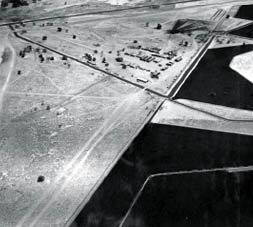 |
 |
|
Growing rice
In response to wartime food shortages, in 1942 the Commonwealth Government asked NSW to consider lifting its ban on rice growing in the Southern Riverina. Rice was an “essential foodstuff,” and more local production was required “to meet the nation’s commitments to its allies.” Four experimental crops were established, two in the Wakool District and two in the Berriquin District. The following year Tulla Estate near Wakool was chosen as the site for southern rice production, with a total of 5,000 acres of rice to be grown. Following World War II rice production continued in the Wakool District and the newly created Tullakool Irrigation Area (formerly Tulla Estate). Approval for rice growing was gradually extended to the other districts following pressure from landholders. Berriquin was the last district to be approved for rice, in 1967. Landholders were keen to become rice growers because the crop offered them an opportunity to diversify production and generated new income through summer cropping. Most existing farm machinery could also be easily converted for rice. Restrictions have always applied to rice growing in the region. Initially landholders could only plant areas of up to 50 acres a year, on soils which had been deemed suitable. Land could only be cropped for rice once every four years. |
Tulla Estate
In 1943, a Prisoner of War camp was established beside Tulla Estate, 14 miles from Wakool. Italian POWs were used to provide labour for the WC&IC’s rice growing project. There were initially 100 men at the camp, which can be seen in the photo above. This increased to 175 as labour requirements increased. “. . . it will be appreciated that the POW had to be taught to drive tractors, truck and handle the various farm machinery and in the early stages many difficulties had to be overcome, especially regarding language.” District Engineer, Deniliquin December 1944 Following the war this area was established as the Tullakool Irrigation Area. The land was subdivided and sold with complete irrigation, farm layout and drainage systems in place. Photo: State Water Archives Collection. |
|
| sitemap • credits
& references • copyright • local
history links • contact & contribute • VISITORS |
||

